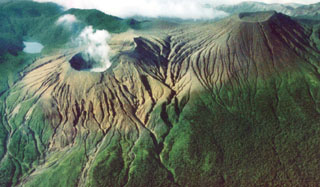Report on Rincon de la Vieja (Costa Rica) — May 1997
Bulletin of the Global Volcanism Network, vol. 22, no. 5 (May 1997)
Managing Editor: Richard Wunderman.
Rincon de la Vieja (Costa Rica) Conspicuous fumaroles and plumes persist
Please cite this report as:
Global Volcanism Program, 1997. Report on Rincon de la Vieja (Costa Rica) (Wunderman, R., ed.). Bulletin of the Global Volcanism Network, 22:5. Smithsonian Institution. https://doi.org/10.5479/si.GVP.BGVN199705-345020
Rincon de la Vieja
Costa Rica
10.8314°N, 85.3364°W; summit elev. 1729 m
All times are local (unless otherwise noted)
During April, fumarolic activity remained in the E and S parts of the main crater. In the latter location, escaping gases hissed like a pressure cooker and were audible from the crater rim. Gas columns rose up to 200 m high. Adjacent to the crater, visitors smelled sulfur gases and their throats, eyes, and skin became irritated. Some of the plants damaged during November 1995 showed new signs of recovery. Although the seismic station (RIN3, located 5 km SW of the active crater) remained out of service during May, earthquake counts numbered five events in December 1996 and 24 in January 1997.
Geological Summary. Rincón de la Vieja is a volcanic complex in the Guanacaste Range of NW Costa Rica. Sometimes referred to as the Rincon de la Vieja-Santa María Volcanic Complex, it consists of a slightly arcuate 20-km-long ridge of 12 craters and pyroclastic cones constructed within the 15-km-wide early Pleistocene Guachipelín caldera, whose rim is exposed on the south side. Sometimes known as the "Colossus of Guanacaste," it has an estimated volume of 130 km3 and contains at least nine major eruptive centers. The Santa María cone, the highest peak of the complex, is located on the E side of the ridge and has a lake within the 400-m-diameter crater. A Plinian eruption producing the 0.25 km3 Río Blanca tephra about 3,500 years ago was the last major magmatic eruption. All subsequent eruptions, including numerous reported eruptions possibly dating back to the 16th century, have been from the active crater, near the center of the complex, with an acidic 300-m-diameter lake.
Information Contacts: E. Fernandez, R. Van der Laat, F. de Obaldia, T. Marino, V. Barboza, W. Jimenez, R. Sáenz, E. Duarte, M. Martinez, E. Hernandez, and F. Vega, Observatorio Vulcanológico y Sismológico de Costa Rica, Universidad Nacional (OVSICORI-UNA), Apartado 86-3000, Heredia, Costa Rica.

